Adding lights to your vehicle
If you want to fit extra lights to your vehicle such as driving lights, fog lamps and search lamps they must meet the standards listed on this page.
Extra driving lamps, fog lamps or work lamps must be fitted in a way that they do not:
- block the driver's view of the road
- stick out in a way that could injure a person close to the vehicle.
These lamps may not be allowed in other states and territories.
Main or high beam headlamps and driving lamps
Vehicles with a gross vehicle mass (GVM) of less than 12 tonnes may have a maximum of four main beam headlamps.
Vehicles with a GVM of more than 12 tonnes may have a maximum of six main beam headlamps.
Driving lights or spotlights can be fitted in addition to main beam headlamps and can include LED light bars and spotlights.
If you get a driving lamp exemption, you can have as many as eight main beam and driving lights fitted to your vehicle.
If you are fitting main or high beam headlamps and driving lamps to your vehicle, keep in mind the following:
- driving lamps can be mounted at any height, but must be set at equal positions on each side of the front of the vehicle
- LED light bars must be fitted in the front centre of the vehicle as shown in the diagram below
- light from a main beam head lamp or driving lamp must be directed so it does not cause problems for other drivers
- all driving lamps must turn off when the vehicle's main beam head lamps are set to low beam (dipped).
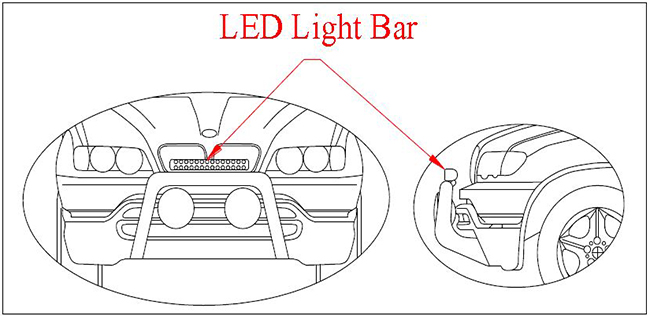
Fog lamps
Fog lamps are used when it is hard to see due to fog, smoke, dust and heavy rain.
A vehicle may be fitted with no more than two fog lamps that must be mounted:
- symmetrically
- no higher than the top of the dipped beam headlamps
- less than 400mm in from the sides of the vehicle
- at least 600mm apart
- at least 250mm from the ground.
The fog lamp beam must angle slightly downwards so the top of the fog lamp beam is lower than the actual fog lamp at a distance of 8m.
Fog lamps must work independently of the headlights and driving lamps.
Light from these lamps must not reflect into the driver's eyes.
Search or work lamps
Search or work lamps are extra lights used for checking loads, reading road signs and seeing off the road. They can be fitted anywhere on a vehicle.
Drivers must take care not to dazzle themselves or other road users with these lights.
More information
For more information get a copy of V14 NT Additional lighting (driving, fog and search lights) PDF (609.4 KB)
Alcohol, drugs and driving
Safe driving requires good judgement and sharp concentration.
You need to react quickly to changing situations on the road.
Drinking alcohol and taking drugs reduces your ability to drive safely.
They can affect your:
- vision
- speed and distance judgments
- reflexes and reaction times
- decision-making
- concentration.
Drinking alcohol also increases risk-taking behaviour by giving a driver a false sense of confidence.
Drinking and driving
It's best that you don't drink alcohol before driving.
If you are over the legal blood or breath alcohol limit, you could face drink-driving penalties, and put you and other road users at risk.
What is a blood or breath alcohol concentration (BAC)
A blood or breath alcohol concentration (BAC) is the amount of alcohol in your body.
Your blood alcohol concentration is measured in a percentage per 100ml of blood.
You breath alcohol concentration is measured in a percentage per 210 litres of breath exhaled.
For example, a BAC of 0.05% means your body contains 50mg of alcohol per 100ml of blood.
Standard drinks and driving
As soon as you start drinking, the level of alcohol in your blood or breath starts to rise.
A standard drink contains about 10g of alcohol.
As a guide one standard drink includes any of the following:
- 100ml of wine
- 375ml mid strength beer
- 285ml of full strength beer
- 30ml of spirits.
The level of alcohol in your blood or breath is affected by a number of factors including any of the below:
- amount of alcohol you drink
- the time over which you drink it
- your body mass
- how much food you've eaten
- your health.
Everyone is different but as a guide:
- men should not drive if they have drunk more than two standard drinks in the first hour and more than one standard drink every hour after that
- women should not drink more than one standard drink in an hour before driving.
If you're going to drink, it is safer to arrange a Sober Bob to get you home - read more about Sober Bob below.
Alcohol limits for drivers in the NT
In the NT you must stay below the blood or breath alcohol limit for your class of driver licence.
Alcohol limit for your class of driver licence
| Licence classification | 0% BAC | Under 0.05% BAC |
|---|---|---|
| Learner licence | X | |
| Provisional licence | X | |
| Full licence (car or rider) on Z condition | X | |
| Full licence (car or rider) | X | |
| Approved driving instructors who are teaching | X | |
| Public passenger vehicle drivers – bus, taxi | X | |
| Coach or heavy vehicle (over 15 tonnes GVM or GCM) drivers | X | |
| Dangerous goods vehicle driver | X | |
| Fully licensed drivers from interstate and overseas. | X |
Definition of alcohol limits
The Northern Territory has four alcohol limits.
Zero alcohol limit
You will be over this limit if the concentration of alcohol in your blood or breath is more than zero.
Low range alcohol limit
You will be over this limit and face a drink-driving penalty if the concentration of alcohol in your blood or breath is between 0.05% and 0.079% BAC.
Medium range alcohol limit
You will be over this limit and face a drink-driving penalty if the concentration of alcohol in your blood or breath is between 0.08% and 0.149% BAC.
High range alcohol limit
You will be over this limit and face a drink-driving penalty if the concentration of alcohol in your blood or breath is equal to or more than 0.15% BAC.
Drugs and driving
It is illegal to drive while under the influence of drugs, including some over the counter and prescription medicines.
Taking drugs before puts you at risk of injuring or killing yourself, your friends or others.
Drugs and medications can significantly affect any of the following:
- driving skills
- alertness
- capability
- vision
- reaction time.
Drug testing
Random roadside saliva testing will identify the recent use and presence of the following prohibited drugs:
- THC - the active ingredient in cannabis
- methylamphetamines - also called ice or speed
- MDMA - the active ingredient in ecstasy.
If you test positive on the first saliva test, police will require you to submit a second saliva test at the roadside to confirm the presence of drugs.
The second saliva test will also detect the presence of cocaine, valium and opiates (morphine and codeine).
Blood testing may be used as an alternative if a second saliva test can't be carried out.
Medicines and over-the-counter drugs
Many prescription and some over the counter medicines can affect your ability to drive and could make you unfit to drive.
They can affect your concentration, mood, coordination and reactions as a driver.
When you receive a prescription for a drug by your doctor you should ask whether the drug will affect your driving.
Read the label on prescription medication and other over the counter products to check that they do not contain alcohol (also known as ethanol), or contain a warning about possible effects on your driving ability.
Do not drive while taking medicines with a warning label that tells you not to drive.
Do not drive if any medication affects your ability to control a vehicle.
Some medicines that can affect driving include any of the following:
- pain killers
- medicines for blood pressure, nausea, allergies, inflammations and fungal infections
- tranquillisers, sedatives and sleeping pills
- diet pills
- cold and flu medicines.
How you can be safe
If you are going to drink or take drugs, you must not drive.
You should plan how you will get home, stay overnight or arrange a Sober Bob.
A Sober Bob is someone who is willing to get you home safely. They can be a bus driver, taxi driver, mum, brother or friend. Read more about Sober Bob in the Road Safety website.
Know your limits when drinking.
Bicycle safety
To keep everyone safe, both cyclists and motorists need to consider each other and share the road safely.
Cyclists and motorists are more vulnerable on the road because:
- they have less protection than other motorists
- are more likely to be injured in the event of a crash.
Cyclists have the same rights and responsibilities as other road users.
It is important that all cyclists obey the road rules.
For more information, read the following guides:
Cycling safety fact sheet PDF (456.5 KB)
Cycling safety brochure PDF (1.9 MB)
Approved bicycle helmets
Approved bike helmets provide improved protection in case of an accident or crash with another rider, pedestrian or vehicle.
Your helmet must meet the Australian standards as well as being properly fitted and fastened.
If you're 17 or under, you must wear an approved helmet if you're riding on a public place or footpath.
If you're over 17, you are not required to wear a helmet on a public place or footpath unless riding on the road.
However, to keep everyone safer regardless of age, it is best to always wear a helmet.
Helmet safety check
The helmet must meet all of the following:
- have an Australian Standards sticker
- not be broken or damaged
- fit snugly and must not be too tight or too loose
- cover the forehead and temples
- have a chinstrap clip that is not broken and fastens firmly.
Check the rider can put the helmet on and buckle up the clip.
How to fit a child's helmet
A helmet should fit snugly.
A helmet that is too small will not protect the head properly and you should purchase the next size helmet.
Carefully measure your child's head using a tape measure. The tape measure should sit just above their eyes and ears.
Check the helmet size listed on the display box to find a helmet that best suits your child's head measurement.
Manufacturers provide pads that can be attached to the inside of the helmet. Use the thicker pads to get a snug fit. As your child grows replace these with the thinner pads or purchase helmets which have adjustable rear head locks for a better fit.
Check the helmet fits
You should follow these steps:
Step 1. Place the helmet on your child's head checking that it fits snugly.
Step 2. Adjust the straps over the ears and do up the buckle - it should sit straight on your child's head with room for one finger under the chin strap.
Step 3. Place your palm under the front of the helmet and push up and back - the helmet should not move.
For maximum protection the helmet must be a snug fit and securely fastened. If a helmet is loose it increases the risk of injury.
Safety equipment on your bike
All of the following are the minimum you must have on your bike:
- a bell or horn in good working order
- a white reflector at front
- a brakes that works
- a red reflector at the rear.
If you are riding at night you must have a white front light and red rear light.
Bike safety checklist
You should check all of the following:
- The seat is the right height and stable so it does not tip or twist.
- The wheels do not turn when the brakes are applied and there are no loose or broken spokes.
- The tyres are hard and no worn patches or bulges can be seen and the valves are straight and capped.
- The pedals are in good condition and spin freely.
- The chain works smoothly without sticking and is clean.
- There is a white reflector on the front and red reflector on the back of the bike, and yellow reflectors on the wheels.
The bike is the correct size if your child can straddle the bike and they have at least their toes touching the ground on both sides and can reach the handlebars.
Carrying a child in a bike trailer
Cycling safety rules
All of the below are some main road rules cyclists must follow:
- ride your bicycle correctly with a least one hand on the handlebars while in motion
- sit astride or stand on the seat facing forwards - unless the bike is designed otherwise
- always ride on the left unless overtaking or giving way to pedestrians
- you must not ride more than two bicycles abreast on a road
- you must use correct signals to turn left or right and to stop
- keep more than 2m from the rear of a vehicle
- do not hold onto a moving vehicle while riding
- do not overtake on the left of a vehicle if the vehicle is moving and indicating to turn left
- use the left lane of a roundabout when you are turning right - providing you give way to all exiting traffic
- ride with an approved helmet if you are:
- under 17 years old
- riding on the road.
If you don't follow these rules, you may face cycling offences and penalties.
Riding on the footpath or bike path
You must follow these rules to make sure you safely share the footpath or bike path with other users:
- keep to the left of any oncoming bicycle rider or pedestrian
- give way to pedestrians
- use your bell or horn to warn others, especially when riding up behind them.
You are permitted to ride slowly across a road on a children's crossing or pedestrian crossing.
Riding slowly means at a walking pace.
You must do the following:
- give way to pedestrians on crossings
- only ride across a signalised crossing if it is showing a green bicycle and/ or green pedestrian crossing light.
Riding on the road
You must follow these rules:
- ride close to the far left side of the road
- obey all road rules including traffic signs, lights and road markings
- always give hand signals to indicate which direction you are about to travel
- don't ride past, or overtake, to the left of a vehicle that is turning left
- don't cause a traffic hazard by moving into the path of a driver or pedestrian
- don't carry a load that flaps, sways or overhangs the sides, front or back of the bicycle.
Riding your bike at night or in poor weather conditions
You must use all of the following on your bike to make sure other road users can clearly see you on the road:
- front light - a flashing or steady white light that is clearly visible for at least 200m
- rear light - a flashing or steady red light that is clearly visible for at least 200m
- rear red reflector –-that is clearly visible for at least 50m from the rear of the bicycle.
Sharing the road with cyclists
Drivers must be aware and respectful of riders on the road.
Drivers should always look for cyclists and expect the unexpected.
Drivers must do all of the following:
- keep a safe distance and leave at least 1m when overtaking cyclists if travelling under 60km/h
- leave at least 1.5m if travelling more than 60km/h
- look for cyclists' hand signals so you are aware of their intentions
- watch for pedestrians and cyclists when leaving or entering a driveway
- cyclists can legally ride two abreast - be patient as you approach and overtake only when safe
- give cyclists space when sharing the road as sometimes they need to ride out of a lane to avoid a hazard or obstacle.
When passing a cyclist, you are permitted to:
- move across lanes or straddle lanes - where a vehicle is positioned over lane lines
- drive to the right of the middle of the road
- cross over or drive to the right of the dividing line, including double solid lines
- drive on or over continuous lines around a painted island
- drive on a dividing strip that is at the same level as the road.
These exemptions only apply if you have a clear view of any approaching traffic and it safe to do so.
For more information, view the Wider of the Rider video on the Towards Zero Road Safety NT website.
Cyclists turning on the road
You can turn right from either the left or right lane of a multi-lane roundabout. If you use the left lane, you must give way to any vehicle leaving the roundabout.
You can turn right at an intersection by making a hook turn unless prohibited by a sign on the road.
Bike education for children
It is important that children learn the road rules and about bike safety before riding on the road.
Free bike education lessons are available to schools during school hours at the:
- Parap Road Safety Centre in Darwin (term two and term three)
- Newland Park Safety Centre in Alice Springs.
Most schools in the NT run classes through the road safety centres. Educators can book a bike safety lesson.
Parents in Darwin can also use the Parap Road Safety Centre's miniature road system outside of school hours if they want their child to experience what it is like to ride on the road with street signs. There is no fee to use the road system.
Cyclists and heavy vehicles
Many urban and regional roads in the Northern Territory are used regularly by heavy vehicles, including trucks, buses and road trains to transport goods.
When riding with heavy vehicles, remember that they:
- are longer than other vehicles and take more time and distance to stop
- need more room to turn at intersections and roundabouts
- have ‘blind spots’ where the driver may not be able to see other road users.
You should avoid riding on the inside of turning vehicles.
Cycling in remote areas
If you want to cycle in a remote area, make sure you plan ahead.
Remote areas, towns and communities in the NT may be hundreds of kilometres apart.
When planning a long distance cycling journey, find out where you can access water and basic services.
Allow time for repairs and unexpected events, and plan for emergencies.
You should do the following:
- check road and weather conditions
- know the distances between towns
- always wear a correctly fitted, fastened and approved helmet
- be visible and wear bright, light-coloured clothing that provides protection from the sun
- be aware of road trains and heavy vehicles
- carry a bike repair kit, food, and plenty of water - stay hydrated
- avoid riding at night.
Book a bike safety lesson
Teachers can book a bicycle safety lesson for students at the Parap Road Safety Centre in Darwin or the Newland Park Centre in Alice Springs.
The lessons are run by road safety officers and help students learn all of the following:
- the basics of riding safely around roads
- their requirements under Northern Territory road rules
- how to perform a bike check.
Before you book
The Parap Road Safety Centre only operates bike education lessons in school terms two and three. Lessons at this centre are for students in grades four to six.
The Newland Park Centre in Gillen operates throughout the school year. Bike safety lessons at this centre are for students in grades two to six.
How to book
To book a bike safety education session or workshop, follow these steps:
Step 1. Apply online on the Road Safety NT website or fill in the road safety education booking form DOCX (650.8 KB).
Step 2. Email your completed form to roadsafety@nt.gov.au.
More information
To find out more about the road safety schools session and workshops, go to the Road Safety NT website or call 08 8924 7019.
Book road safety lesson for children
Childcare providers and educators can book a road safety lesson run by road safety officers.
The lessons teach children road safety skills to keep them safe as road users and pedestrians.
Below are the available road safety lessons.
Childcare or early learning road safety lesson
The Hector the Road Safety Cat show is available for childcare centres, preschools, early childhood assemblies and special events across the Northern Territory (NT).
Hector is the NT's road safety mascot. His road safety show is a fun and interactive way to teach children about the importance of being road aware.
The show runs for about 15 to 20 minutes.
Hector's road safety message
Hector's road safety song 'stop, look, listen, think' is central to the road safety message he teaches children.
- Stop – stop at the kerb. Make sure it is safe to cross
- Look – look to your right and then to the left. Can you see any traffic?
- Listen – listen carefully with your ears. Can you hear any traffic?
- Think – think with your brain. Is it safe to cross?
- Walk – walk straight across. Don't run. Keep looking and listening for traffic as you cross.
Below are some resources you can use:
- Hector the Cat's activities and song lyrics PDF (1.5 MB)
- 'Stop, look, listen and think' song
Preschool and primary school road safety lesson
A road safety officer will visit individual classrooms to deliver the lesson based on:
- passenger safety
- pedestrian safety
- safety on wheels
- sensing traffic
- road rules
- signs and playing safely.
The Hector the Road Safety Cat show is available for Preschool visits and Primary School assemblies. Read more about the show in the childcare or early learning road safety lesson section.
Middle year school road safety lesson
A road safety officer will visit individual classrooms to deliver the lesson that includes teaching students:
- the importance of health and safety issues and practices
- the skills necessary to make decisions that may affect their health and safety
- how to foster positive health and safety attitudes and behaviours.
Senior years road safety lesson: Choices program
The Choices program has been designed for senior secondary students, and may align with teaching and learning programs at year 10 and stage one level.
The program involves NT Police, Fire and Emergency Services, St John Ambulance and road safety officers.
The program can be incorporated into an NTCET program in two ways:
- as a focus within a program
- reinforcing road safety messages addressed in other ways within a program.
The program may not directly align with the learning outcomes of the subject, but it can reinforce important messages with regard to being safe on NT roads – eg:
- in English - students may study road safety texts
- in maths - students may study road safety statistics.
The program has two parts:
- the first part teaches students about road safety including:
- safe systems approach to road safety
- road safety statistics and facts
- influencing factors on road crashes
- the cost and consequences of crashes
- road user behaviour
- harm reduction strategies
- the second part involves a case study presented by NT Police, Fire and Rescue service.
Remote community road safety lesson
Road safety officers will visit remote and regional schools to deliver a Hector the Road Safety Cat show and lessons based on your school needs.
Find more about the show in the childcare or early learning road safety lesson section.
How to book
To apply for a road safety lesson, follow these steps:
Step 1. You can either:
- apply online on the Road Safety NT website or
- fill in the road safety booking form DOCX (650.8 KB).
If you're applying for the Choices program, and would prefer to use a form, you must fill in the Choices program booking form for senior years DOCX (33.7 KB).
Step 2. Email your completed form to roadsafety@nt.gov.au.
Contact
For more information, go to the Road Safety NT website call 08 8924 7019.
Book road safety workshop
Workplace road safety is an important occupational health safety issue.
Research shows that road crashes are the most common cause of work-related fatalities, injuries and absences from work.
You can book a road safety workshop or presentation for your workplace to improve the safety of employees driving on Northern Territory (NT) roads, especially long distances.
Road safety workshops and presentations are for any of the following:
- business and community leaders
- staff from community organisations or large businesses
- industry groups
- community members.
Workshop topics
The workshop focuses on key road safety issues including all of the following:
- different road conditions
- vehicle safety
- speed and driver behaviour
- information on the deaths and injuries on local roads
- local road safety challenges and strategies to keep safe.
How to book
Email roadsafety@nt.gov.au or phone (08) 8924 7420.
Campaigns and initiatives
You can access all the latest Northern Territory road safety campaigns, initiatives and strategies from the Towards Zero Road Safety NT website.
Check road conditions
This page has information on how to check road closures and road conditions in the Northern Territory.
NT government roads
Go to the government's Road Report website.
This website also has information on the condition of roads on Aboriginal land.
Permits may be required when travelling on roads through Aboriginal Land. Contact the relevant land council for further information.
Freecall: 1800 246 199.
Council roads
To check the conditions of roads managed by councils, contact the local council.
Find out more about roads managed by the NT Government.
NT parks – 4WD and 2WD tracks
To find out about access to parks, check the following:
This includes access information on the following parks and reserves:
- Berry Springs
- Butterfly Gorge
- Casuarina point coastal reserve
- Charles Darwin National Park
- Djukbinj National Park
- Douglas River/Daly River Esplanade
- Fog Dam
- Garig Gunak Barnu National Park
- Harrison Dam
- Holmes Jungle Nature Park
- Howard Springs Hunting Reserve
- Howard Springs Nature Park
- Knuckey Lagoons Conservation Reserve
- Leaning Tree Lagoon Nature Park
- Leanyer Recreation Park
- Litchfield National Park
- Manton Dam Recreation area
- Mary River National Park
- Palmerston Water Park
- Point Stuart Coastal Reserve
- Shoal Bay Coastal Reserve
- Territory Wildlife Park
- Tjuwaliyan (Douglas) Hot Springs
- Tree Point Conservation Area
- Umbrawarra Gorge Nature Park
- Window on the Wetlands.
National parks
Kakadu National Park road and access report
Uluru-Kata Tjuta National Park passes and permits
Other states
Visit the ACT website
Phone: 02 6207 2500
Visit the NSW website
Phone: 13 27 01
Visit the Queensland website
Phone: 1300 130 595
Visit the SA site
Phone: 1300 361 033
Visit the Tasmania site
Phone: 1300 135 513
Visit the Victoria site
Phone: 13 11 70
Visit the Main Roads WA website
Phone: 1800 013 314
Road terms
To read the road conditions terminology, go to the road design standards page of the Department of Infrastructure, Planning and Logistics website.
Driving safety checklist
All drivers should plan and prepare for a safe journey before leaving home, no matter how far you are driving.
The Northern Territory (NT) has vast stretches of variable speed and surfaced roads.
Road conditions can change quickly, particularly in the wet season during October to May.
You will encounter may types of road users travelling at different speeds and under different conditions.
You should follow this checklist to help keep you and others safe on the road.
Before you leave
You should do all of the following:
- check your vehicle is safe and roadworthy
- check road conditions and weather reports
- don't drive tired, plan for road rest stops every two hours.
Vehicle safety check
You should check all of the following:
- lights, wipers and washers are in working order
- fluid levels (water, brake, radiator, battery)
- tyres and spares tyres - inflated as specified
- the vehicle is not overloaded
- your vehicle registration is current and covers you for the entire journey.
Tips to avoid distractions
Turn off your mobile phone, even if it is hands free.
Make adjustments to your radio or CD player before you start driving.
Check on a map where you are going before you leave.
Ensure that your vehicle's windscreens, mirrors and windows are clean and unobstructed.
Ensure pets are correctly restrained by using a secured carry box or a pet seatbelt.
Take a break and pull over rather than eating, drinking, smoking or grooming when you're driving.
Plan activities to keep your children happy and quiet.
Tips when you're on the road
Obey the road rules.
Wear your seatbelt and carry children in approved child restraints.
Drive within the speed limit and your own capability.
Drive to the road and weather conditions.
Stay focused on the road and avoid distractions while driving.
Share the road safely with others including road trains and cyclists.
Take care through school zones and rail crossings.
Expect the unexpected - watch out for pedestrians and animals.
Don't drive in convoys especially if you are towing a caravan.
Reduce your speed on unsealed roads.
Driving tips for visitors to the NT
Visitors should also read the driving in the NT guide PDF (1.5 MB) available in:
You should also consider taking out membership of a national motoring body with 24-hour roadside assistance such as the AANT.
Driving with road trains
Road trains and other heavy vehicles need more space on the road and take longer to stop.
You should follow these safety tips on driving with road trains:
- be patient - do not cut in front of road trains, especially when they are slowing down at traffic lights or turning
- do not overtake a turning road train and give them space and time
- keep your distance when travelling behind road trains on unsealed roads and use your headlights
- slow down and pull off the road and drive slowly on the shoulder of the road when approaching an oncoming road train on a single lane highway
- don't drive in convoys, especially if you are towing a caravan.
Being overtaken by a road train
When a road train starts to overtake your vehicle:
- Maintain your speed.
- Keep left and don't move off the road.
- Only slow down once the road train moves out to pass.
When the road train has passed flash your headlights to let the driver know that it is safe to move back in.
Overtaking a road train
Before overtaking:
- Stay well back when behind a road train.
- Make sure the driver can see you in one of their mirrors.
- Be certain you can see enough clear road space ahead.
- Only overtake when you are confident you can safely do so.
When overtaking:
- Signal, move out and pass quickly but sensibly.
- Don't move back in until you see both the road train's headlights in your mirrors and don't slow down.
Stopping distances for road trains
You must allow more time to stop safely when driving behind a heavy vehicle or road train. Road trains take longer to stop.
The table below shows comparisons of stopping distances for cars and trucks when driving at the same speeds.
| Vehicle speed | Car stopping distance | Truck stopping distance |
|---|---|---|
| 60km/h | 70m | 83m |
| 70km/h | 89m | 107m |
| 80km/h | 110m | 133m |
| 90km/h | 133m | 162m |
| 100km/h | 157m | 194m |
If driving in hazardous weather conditions - eg: wind or dust - always leave more room when driving behind a heavy vehicle or road train.
Electric scooters and bikes
If you want to use an electric scooter, also known as an e-scooter, you don’t need a driver licence or learner permit.
But you must follow the rules below.
If you don’t, you may be fined, receive demerit points or have your licence disqualified.
To use an electric bike (e-bike), you must ride them how you would ride a regular bicycle. Read more about bicycle safety.
You can hire e-scooters and e-bikes in the Darwin area, under an agreement with Beam Mobility Australia and the City of Darwin. Find out more on the City of Darwin website.
Rules for riding a Beam e-scooter
You can only use e-scooters in public places if they're provided by Beam Mobility Australia.
To hire and ride an e-scooter, you must:
- be at least 18 years old
- wear an approved bike helmet that is securely fitted
- only ride on footpaths and shared paths and bicycle lanes, unless prohibited
- keep to the left
- give way to any pedestrians.
You can only travel on a road for a distance of less than 50m if:
- there is an obstruction on a footpath, nature strip, or shared path
- it is impracticable to travel on the adjacent area.
You must also not:
- carry passengers or use a mobile phone
- have a blood alcohol concentration (BAC) of 0.05 or more
- take them on public transport or outside of areas permitted by authorities.
For your safety, scooters are also:
- speed limited to 15 km/h
- fitted with an electronic warning device eg. bell
- fitted with front and rear lights which must be operating for use at night.
Rules for riding your own e-scooter
If you own an e-scooter, you can only ride it on private property.
You can’t ride it on roads, footpaths or other public spaces.
If you're caught riding an unapproved e-scooter, you may be fined for driving an unregistered and uninsured motor vehicle.
Read about traffic offence fines and demerit points.
Contact
For help, contact Beam:
- through the ‘support’ button of their app
- by calling their helpline 1300 507 676 (toll-free number)
- via email to teamsupportau@ridebeam.com.
To report a Beam vehicle or rider, submit a report on the Beam website. Include the registration number (if possible) and details of the rider's behaviour including location and time.
If the rider is breaking the law or using a privately owned e-scooter or e-bike, refer the matter to the police.
Fatigue and driving
If you are driving long distances in the Northern Territory (NT), you should plan to take a break every two hours so that you do not become affected by fatigue.
Fatigue reduces your ability to drive safely as well as your judgement, reaction times and ability to control your vehicle.
Warning signs of fatigue
The signs include any of the following:
- yawning
- sore or heavy eyes
- dim or fuzzy vision
- stiffness and cramps
- delayed reaction times
- drifting lanes.
Tips to avoid driving tired
You should do all of the following:
- plan to stop at road rest areas in the NT
- stop for a 15 minute break every two hours of driving
- take a walk to stretch your legs and drink some water
- consider changing drivers if possible.
How to secure loads on your vehicle
You could be prosecuted if you don't position or restrain a load correctly on your vehicle.
All loads must be safely positioned on or in a vehicle and be secured.
When transporting any load, you must:
- use a vehicle appropriate for the type of load you are carrying
- position the load correctly
- use suitable restraint equipment in good condition
- check your load restraint before leaving and during the trip.
How to meet the standards
Restraining a load will meet the load restraint performance standards if it doesn't shift when subjected to the following forces:
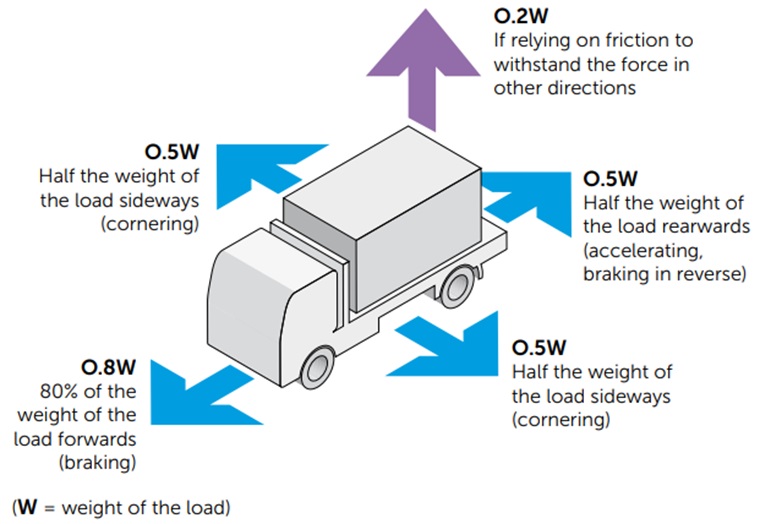
Graphic used with permission from the National Transport Commission.
The load restraint system must be capable of withstanding these forces:
- 0.8 'g' deceleration in a forward direction
- 0.5 'g' deceleration in a rearward direction
- 0.5 'g' deceleration in a lateral direction
- 0.2 'g' acceleration in a vertical direction if relying on friction to withstand forces in other directions.
'G' means gravitational acceleration or 9.81m/s squared.
More information
For more information, read the v64 load restraint information bulletin PDF (362.7 KB)
Light trailer safety chains and shackles
When towing a light trailer you must use suitable safety chains. You must make sure they are correctly attached to the towing vehicle.
Trailers are categorised by their aggregated trailer mass (ATM). This is the combined weight of the trailer and its maximum legal load.
A light trailer is one that has an ATM of up to 4,500kg and can also include caravans and boat trailers.
The ATM will be listed on the trailer's Vehicle Identification Plate.
Shackles can be used to connect the safety chain to the towing vehicle.
Safety chains
Trailers with an ATM up to 2,500kg only need one chain rated to the capacity of the trailer.
Trailers with an ATM over 2,500kg and up to 3,500kg ATM must use two chains each rated to at least 3,500kg.
Trailers with an ATM over 3,500kg must use two chains rated to at least 4,500kg.
Read the light trailer requirements bulletin PDF (859.3 KB).
Shackles
When using shackles you must ensure you choose the right one to connect the trailer's safety chain to the towing vehicle.
The table below lists recommended bow or D-shackles to suit light trailers with an aggregated mass up to 3,500kg.
The sizes are based on the diameter of the shackle.
| Trailer ATM (kg) | Minimum shackle Working Load Limit (kg) | Grade M (or 4) D-Shackle (mm) | Grade S (or 6) D-Shackle (mm) | Grade S (or 6) Bow-Shackle (mm) |
|---|---|---|---|---|
| 0-1000 | 250 | 6 | 6 | 5 |
| 1001-1600 | 400 | 10 | 6 | 6 |
| 1601-2500 | 625 | 13 | 8 | 8 |
| 2501-3500 | 875 | 16 | 10 | 10 |
For more information about safety chain connection devices for road trailers, go to the Australian Government's Department of Infrastructure, Transport, Regional Development and Communications website.
Shackles may also be used on trailers over 3,500kg and up to 4,500kg as long as the rating of each shackle meets a minimum break load limit of 4,500kg.
For more information on suitable safety chain connection devices for trailers over 3,500kg contact the Vehicle Standards unit at the Motor Vehicle Registry.
Rail crossings
Trains have the right of way at rail level crossings.
Trains are fast and quiet and can come from either your left or your right side – 24 hours a day. It's difficult to judge the speed and distance of approaching trains.
You can also report a fault or incident to the National Rail Safety Regulator.
Tips for safe crossing of railway tracks
Stop, look and listen before you cross a rail level crossing.
Obey all stop and give way signs.
Obey all warning signs when lights are flashing and booms gates are down - don't cross the track until the lights have stopped flashing.
Only cross the tracks at designated rail level crossings.
For more information on rail safety go to the National Rail Safety Regulator website.
Report a road fault
You should report any faults or hazards that present a risk to the safety of road users.
These may include:
- fallen trees
- flooding or water over road
- malfunctioning irrigation systems
- litter or vandalism
- road damage such as potholes
- broken signs.
For urgent road faults, call 1800 246 199.
For non-urgent road faults, submit a report below.
This service is for NT Government-controlled roads only. Check which roads are managed by the NT Government.
To report problems with street lights, go to the Power and Water website.
To report faults on locally-controlled roads and streets, contact your local or regional council.
Report a traffic light fault
Find out how to report a traffic light fault.
Report a bike path fault
Find out how to report a bike fault.
Contact
For more information, email roadreporting.ntg@nt.gov.au or call 08 8999 4752.
Report a bus stop issue
Keeping bus stops clean, safe and free of any faults helps buses run smoothly.
If you see any problems at a bus stop, you can report them easily by scanning the QR code at any Territory bus stop.
You can also get in touch directly by:
- phone 08 8924 7666 Monday to Friday 6:45am to 4:30pm
- email public.transport@nt.gov.au
- through the feedback form on the Department of Infrastructure, Planning and Logistics website.
Report a traffic light fault
You can report a traffic light fault, damage or other traffic light issues in Darwin, Palmerston, Katherine, Tennant Creek and Alice Springs including:
- broken glass
- light out
- flashing amber
- vandalism
- structural damage
- blacked out
- vehicle detector
- pedestrian crossing.
Problems with street lights should be reported on the Power and Water website.
You can also report a traffic light fault in the Northern Territory by calling 1800 246 199.
Road crash statistics
You can access road crash statistics on the Towards Zero Road Safety NT website.
This includes road toll information and fatalities in accidents for all of the following:
- drivers
- passengers
- motorcyclists
- cyclists
- pedestrians.
You can also access road toll information for previous years up to 2011.
For more information, go to the Towards Zero Road Safety NT website.
Road rest stops in NT
If you are driving long distances in the Northern Territory (NT), you should plan to take a break every 2 hours so that you don't become affected by fatigue.
Stuart Highway
Rest stops on the Stuart Highway are included in 4 different route maps.
Darwin to Katherine
| Rest stop | Distance | Facilities |
|---|---|---|
| Manton Dam | Nearest town south: Katherine (249km) Nearest stop south: Coomalie Creek (21km) Darwin (66km) |
|
| Coomalie Creek | Nearest stop north: Manton Dam (21km) Nearest town south: Katherine (228km) Nearest stop south: Bridge Creek (59km) Darwin (87km) |
|
| Bridge Creek | Nearest stop north: Coomalie Creek (59km) Nearest town south: Katherine (169km) Nearest stop south: King (215km) Darwin (146km) |
|
Katherine to Tennant Creek
| Rest stop | Distance | Facilities |
|---|---|---|
| King | Nearest town north: Katherine (46km) Nearest stop north: Bridge Creek (25km) Nearest town south: Tennant Creek (624km) Nearest stop south: Warloch (96km) Darwin (361km) |
|
| Warloch | Nearest town north: Katherine (142km) Nearest stop north: King (96km) Nearest town south: Tennant Creek (528km) Nearest stop south: Alexander Forrest Memorial (77km) Darwin (457km) |
|
| Alexander Forrest Memorial | Nearest town north: Katherine (219km) Nearest stop north: Warloch (77km) Nearest town south: Tennant Creek (451km) Nearest stop south: Sir Charles Todd Memorial (125km) Darwin (534km) | |
| Sir Charles Todd Memorial | Nearest town north: Katherine (344km) Nearest stop north: Alexander Forrest Memorial (125km) Nearest town south: Tennant Creek (326km) Nearest stop south: Newcastle Waters (52km) Darwin (659km) | |
| Newcastle Waters | Nearest town north: Katherine (396km) Nearest stop north: Sir Charles Todd Memorial (52km) Nearest town south: Tennant Creek (274km) Nearest stop south: Attack Creek (202km) Darwin (711km) |
|
| Attack Creek | Nearest town north: Katherine (598km) Nearest stop north: Newcastle Waters (202km) Nearest town south: Tennant Creek (72km) Nearest stop south: Reverend John Flynn Memorial (47km) Darwin (913km) |
|
| Rev John Flynn Memorial | Nearest town north: Katherine (645km) Nearest stop north: Attack Creek (47km) Nearest town south: Tennant Creek (25km) Nearest stop south: Bonney Well (114km) Darwin (960km) |
Tennant Creek to Alice Springs
| Rest stop | Distance | Facilities |
|---|---|---|
| Bonney Well | Nearest town north: Tennant Creek (89km) Nearest stop north: Reverend John Flynn Memorial (114km) Nearest town south: Alice Springs (416km) Nearest stop south: Devils Marbles (14km) Darwin (1074km) |
|
| Devils Marbles | Nearest town north: Tennant Creek (103km) Nearest stop north: Bonney Well (14km) Nearest town south: Alice Springs (402km) Nearest stop south: Taylor Creek (81km) Darwin (1088km) |
|
| Taylor Creek | Nearest town north: Tennant Creek (184km) Nearest stop north: Devils Marbles (81km) Nearest town south: Alice Springs (321km) Nearest stop south: Teamster Memorial (97km) Darwin (1169km) |
|
| Teamster Memorial | Nearest town north: Tennant Creek (281km) Nearest stop north: Taylor Creek (97km) Nearest town south: Alice Springs (224km) Nearest stop south: Central Mount Stuart (12km) Darwin (1266km) | |
| Central Mount Stuart Historical Reserve | Nearest town north: Tennant Creek (293km) Nearest stop north: Teamster Memorial (12km) Nearest town south: Alice Springs (157km) Nearest stop south: Prowse Gap (67km) Darwin (1278km) |
|
| Prowse Gap | Nearest town north: Tennant Creek (360km) Nearest stop north: Central Mount Stuart Historical Reserve (67km) Nearest town south: Alice Springs (145km) Nearest stop south: Ryans Well (22km) Darwin (1345km) |
|
| Ryans Well | Nearest town north: Tennant Creek (382km) Nearest stop north: Prowse Gap (22km) Nearest town south: Alice Springs (123km) Nearest stop south: Connors Well (31km) Darwin (1367km) | |
| Connors Well | Nearest town north: Tennant Creek (413km) Nearest stop north: Ryans Well (31km) Nearest town south: Alice Springs (92km) Nearest stop south: Warburton Memorial (32km) Darwin (1398km) |
|
| Warburton Memorial | Nearest town north: Tennant Creek (445km) Nearest stop north: Connors Well (32km) Nearest town south: Alice Springs (60km) Nearest stop south: Tropic of Capricorn (31km) Darwin (1430km) | |
| Tropic of Capricorn | Nearest town north: Tennant Creek (476km) Nearest stop north: Warburton Memorial (31km) Nearest town south: Alice Springs (29km) Nearest stop south: Highest Point Marker (9km) Darwin (1461km) |
|
Alice Springs to the South Australian border
| Rest stop | Distance | Facilities |
|---|---|---|
| Mt. Polhill | Nearest town north: Alice Springs (61km) Nearest stop north: Highest Point Marker (81km) Nearest stop south: Cannonball Memorial (37km) Darwin (1551km) |
|
| Cannonball Memorial | Nearest town north: Alice Springs (98km) Nearest stop north: Mt Polhill (37km) Nearest stop south: Finke River (28km) Darwin (1588km) | |
| Finke River | Nearest town north: Alice Springs (126km) Nearest stop north: Cannonball Memorial (28km) Nearest stop south: Desert Oaks (42km) Darwin (1616km) |
|
| Desert Oaks | Nearest town north: Alice Springs (167km) Nearest stop north: Finke River (42km) Nearest stop south: South Australia Border (128km) Darwin (1658km) |
|
| NT / SA Border | Nearest town north: Alice Springs (295km) Nearest stop north: Desert Oaks (128km) Darwin (1786km) |
|
Other highways
The following are rest stops in other highways in the NT.
Barkly Highway
| Rest stop | Distance | Facilities |
|---|---|---|
| 41 Mile Bore | Threeways (70km) Camooweal (377km) Nearest stop east: Frewena (62km) |
|
| Frewena | Threeways (132km) Camooweal (315km) Nearest stop west: 41 Mile Bore (62km) Nearest stop east: Wonarah Bore (95km) |
|
| Wonarah Bore | Threeways (227km) Camooweal (220km) Nearest stop west: Frewena (95km) Nearest stop east: Soudan Bore (85km) |
|
| Soudan Bore | Threeways (312km) Camooweal (135km) Nearest stop west: Wonarah Bore (85km) Nearest stop east: Avon Downs (65km) |
|
| Avon Downs | Threeways (377km) Camooweal (70km) Nearest stop west: Soudan Bore (65km) Nearest stop east: Queensland Border (57km) |
|
| NT / QLD border | Threeways (434km) Camooweal (13km) Nearest stop west: Avon Downs 57km) |
Victoria Highway
| Rest stop | Distance | Facilities |
|---|---|---|
| King West | Katherine (34km) Kununurra (475km) Nearest stop west: Limestone (23km) |
|
| Limestone | Katherine (57km) Kununurra (452km) Nearest stop east: King West (23km) Nearest stop west: Mathison (45km) |
|
| Mathison | Katherine (102km) Kununurra (407km) Nearest stop east: Limestone (45km) Nearest stop west: Noel Buntine Memorial (25km) |
|
| Noel Buntine Memorial | Katherine (127km) Kununurra (382km) Nearest stop east: Mathison (25km) Nearest stop west: Sullivan Campground (50km) | |
| Sullivan Campground | Katherine (177km) Kununurra (332km) Nearest stop east: Noel Buntine Memorial (50km) Nearest stop west: Durack Monument (98km) |
|
| Durack Monument | Katherine (275km) Kununurra (232km) Nearest stop east: Sullivan Campground (98km) Nearest stop west: Bradshaw Bridge (19km) | |
| Bradshaw Bridge | Katherine (294km) Kununurra (215km) Nearest stop east: Durack Monument (19km) Nearest stop west: Gregory's Cairn (12km) | |
| Gregory's Cairn | Katherine (306km) Kununurra (203km) Nearest stop east: Bradshaw Bridge (12km) Nearest stop west: East Baines (37km) | |
| East Baines River | Katherine (343km) Kununurra (166km) Nearest stop east: Gregory's Cairn (37km) Nearest stop west: Saddle (58km) |
|
| Saddle | Katherine (401km) Kununurra (108km) Nearest stop east: East Baines (58km) Nearest stop west: Beef Road Monument (59km) |
|
| Beef Road Monument | Katherine (460km) Kununurra (49km) Nearest stop east: Saddle (58km) Nearest stop west: Western Australia border (9km) | |
| NT / WA border | Katherine (469km) Kununurra (40km) Nearest stop east: Beef Road Monument (9km) |
|
Contact
For more information, email assetinformation.dipl@nt.gov.au
Road safety and buses
To help get your child safely to and from school, all parents and caregivers are encouraged to use the below checklist.
- Read the code of conduct on rules for catching a school bus.
- Ensure your child is capable of travelling independently.
- Practice walking your child to and from their bus stop before getting on.
- Ensure your child stays back from the road and waits until the bus stops before getting on.
- Ensure your child waits until the bus leaves before crossing the road.
- Discuss what to do if your child misses their stop - stay on the bus and tell the driver, don't get off at the next stop.
- Discuss backup travel plans in case weather conditions stop bus timetables or routes.
You can also print this list by downloading the student travel planner PDF (676.3 KB).
Road safety information for parents
The following checklist is for parents and primary caregivers to help teach your child about road safety, and to help them get to and from school safely.
You can also print this list as a student travel planner PDF (676.3 KB).
Walking to school with your child
Practice walking to and from school with your child.
Always use the crossings properly.
Wait for traffic to stop before crossing.
Riding to school
Read cycling safety and bike education for children.
Teach your child hot to properly fit their helmet.
Practice riding to and from school with your child.
Talk about the safest places to cross the roads.
Driving to school
You should talk to your child about all of the following:
- always wearing a seatbelt or sitting in a child restraint
- being a safe passenger
- where the safe school drop off and pick up locations are
- using the car door safety to get in and out of the vehicle - rear door closest to the kerb to enter and exit.
Travelling to school by bus
All parents and caregivers are encouraged to use the below list to help get your child safely to and from school by bus.
- Read the code of conduct for school bus travel.
Code of conduct for school bus travel PDF (1.1 MB)
Code of conduct for school bus travel DOCX (302.2 KB) - Ensure your child is capable of travelling independently.
- Practice walking your child to and from their bus stop before getting on.
- Ensure your child stays back from the road and waits until the bus stops before getting on.
- Ensure your child waits until the bus leaves before crossing the road.
- Discuss what to do if your child misses their stop - stay on the bus and tell the driver, don't get off at the next stop.
- Discuss backup travel plans in case weather conditions stop bus timetables or routes.
You can also print this list from the student travel planner PDF (676.3 KB).
Road signs in the Northern Territory
Traffic signs warn you of possible dangers and provide information. They tell you what the rules are and what the road conditions are like.
Find out more below about the meaning of different road signs in the Territory.
If you are a visitor to the Northern Territory, get more information about staying safe on the roads from the Road Safety website.
Regulatory signs
Regulatory signs inform you of traffic laws or regulations. You must obey a regulatory sign or risk facing a penalty or traffic fine.
Regulatory signs are normally placed at the point or beginning of the section where the regulation applies.
They are rectangle in shape – except for the stop, give way and roundabout signs.
The signs are usually black on a white background but sometimes they also have a colour such as red or yellow.
| Sign | Meaning |
|---|---|
 |
Roundabout sign There is a roundabout ahead. |
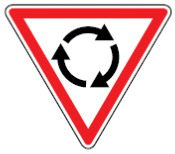 |
Roundabout sign Give way to vehicles on the roundabout. |
 |
Stop sign You must stop your car at the sign or stop line. |
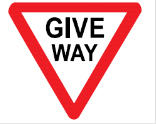 |
Give way sign When turning at an intersection, you must give way. |
 |
Wrong way sign You must turn your vehicle around and go back. |
 |
Keep left sign You must drive to the left of this sign. |
 |
Keep right sign You must drive to the right of the sign. |
 |
One way sign You must only drive in the direction shown by the arrow. |
 |
Two way sign This road now has two lanes of traffic travelling in opposite directions. You must drive to the centre of the road if there is no dividing lane. |
 |
Right lane must turn right sign You must turn right at the intersection. |
 |
Left lane must turn left sign You must turn left at the intersection. |
 |
No Entry sign You must not drive beyond this sign. |
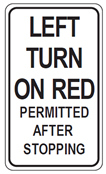 |
Left turn on red light permitted sign You can turn left on a red light after stopping where this sign is displayed. When turning left you must give way to all traffic approaching from the right. |
Warning signs
Warning signs or advisory signs let you know that road changes are coming up on your drive, including potentially hazardous conditions on or near the road.
Warning signs are usually black on a yellow background and are mostly diamond shaped.
| Sign | Meaning |
|---|---|
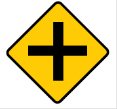 |
Yellow diamond cross sign You are coming up to a crossroad. |
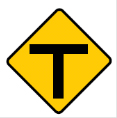 |
Yellow diamond T sign The road you are driving on is about to end, you must give way to all traffic before turning right or left. |
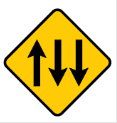 |
Yellow diamond lane change sign The road you are driving on will change ahead to two lanes of oncoming traffic. |
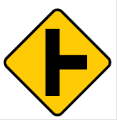 |
Yellow diamond side on T sign The road you are driving on meets a side road to the right. |
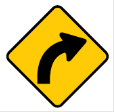 |
Yellow diamond arrow sign – curve sign The road you're driving on curves to the right up ahead. |
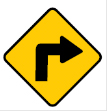 |
Yellow diamond arrow sign – turn sign The road you're driving on turns sharply to the right up ahead. |
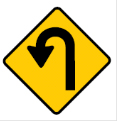 |
Yellow diamond hook arrow sign – hairpin bend The road you're driving on is about to take a sharp bend to the left ahead. |
 |
Yellow diamond bendy arrow sign Winding road ahead. |
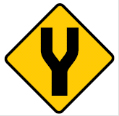 |
Yellow diamond Y sign Road divides ahead. |
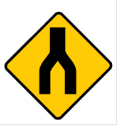 |
Yellow diamond merging sign Divided road ends ahead. |
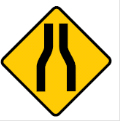 |
Yellow diamond bottle neck sign Road narrows ahead. |
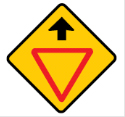 |
Yellow diamond with red triangle sign Give way sign ahead |
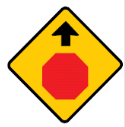 |
Yellow diamond with red hexagon sign Stop sign ahead. |
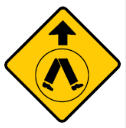 |
Yellow diamond with arrow and walking legs sign Pedestrian crossing ahead. |
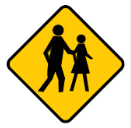 |
Yellow diamond with walking people sign Pedestrians might be crossing ahead. |
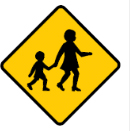 |
Yellow diamond with walking children sign Children might be crossing ahead. |
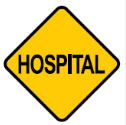 |
Yellow diamond with the word Hospital sign You must drive carefully as there is a hospital ahead. |
 |
Yellow diamond with a bicycle sign You must look out for bicycle riders. |
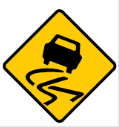 |
Yellow diamond with a swerving car sign The road is slippery when wet. |
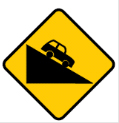 |
Yellow diamond with car on a hill sign There is a steep descent ahead. |
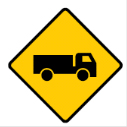 |
Yellow diamond with a truck sign Beware of slow moving vehicles entering traffic. |
 |
Yellow rectangle with the words Traffic Hazard Ahead This sign is used where a temporary emergency situation such as an oil spill, fallen tree or landslip exists on the road ahead. |
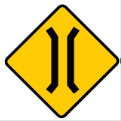 |
Yellow diamond with two parallel indented lines sign There is a narrow bridge ahead on the road and you must slow down and be prepared to give way or stop. |
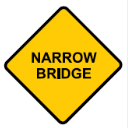 |
Yellow diamond with Narrow Bridge sign There is a narrow bridge coming up. |
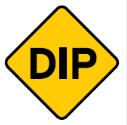 |
Yellow diamond with the word Dip sign The road ahead dips into a sudden down and then up again. |
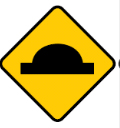 |
Yellow diamond with a bump sign There is a hump in the road ahead. A hump is a sudden slope up and then down. |
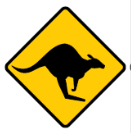 |
Yellow diamond with a kangaroo sign You must look out for kangaroos crossing the road. |
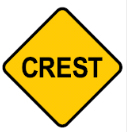 |
Yellow diamond with the word Crest sign As you approach the hill you may not be able to see a safe distance in front of you so drive carefully. |
 |
Yellow diamond with the word Grid sign A grid – a row of metal lengths across the road – is coming up on the road. |
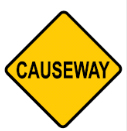 |
Yellow diamond with the word Causeway sign A causeway – which is a raised road that has been built across a low or wet place or a body of water – is coming up on the road you're driving on. |
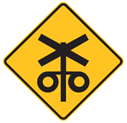 |
Yellow diamond with a pole, cross and circle symbols There is a railway crossing and flashing signal ahead. |
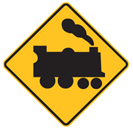 |
Yellow diamond with a train sign You must look out for trains at a railway crossing that is coming up on the road. |
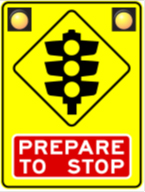 |
Early warning signals - Wig Wags You should prepare to stop at an intersection when you see a wig wag early warning sign with flashing lights. |
Hazard signs
| Sign | Meaning |
|---|---|
 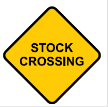 |
Yellow diamond sign with image of cattle Stock may be crossing ahead. |
Variable message signs
| Sign | Meaning |
|---|---|
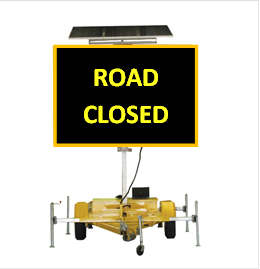 |
Variable Message Signs You must obey the messages warning of changes to normal road conditions – eg: crashes, road works, congestion and road closures. |
Roadwork signs
You must obey any signal from a traffic controller and give way to any worker.
Roadwork signs are used on roads to warn drivers and riders to slow down, look out for any hazards and be prepared to stop. They also show the travel path through, around or past work sites.
Roadwork signs are usually rectangular and have a reflective background, black border and symbol or legend and can be a combination of colours red and black, yellow and black and in some cases occasions black and yellow.
| Sign | Meaning |
|---|---|
 |
Rectangle sign with an image of a person holding a sign There is a traffic controller ahead and you must prepare to stop. |
 |
Rectangle sign with an image of a person digging There are road workers ahead. |
 |
Yellow rectangle sign with the words roadwork ahead You are driving towards road works, slow down and be prepared to stop. |
 |
Yellow rectangle sign with the words end roadwork The road work area has finished and you can resume your normal speed. |
 |
Lolly pop signs stop and slow You must obey these signs that are held by traffic controllers. |
 |
Red square sign with the words prepare to stop You must slow down and prepare to stop. |
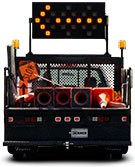 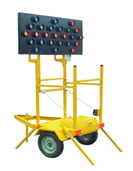 |
Lit arrow sign on vehicle or at the side of the road You are driving toward a road hazard ahead and must merge lanes. |
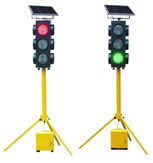 |
Mobile traffic signal device These are temporary traffic lights and the same rules apply for these as normal traffic lights. |
 |
Yellow sign with the words no lines do not overtake unless safe The road you're driving on doesn't have any lines marked on the road and you must take care if overtaking. |
 | Closed lane ahead. |
 |
Yellow rectangle sign with cars and rocks You must watch for loose stones. |
Speed limit signs
| Sign | Meaning |
|---|---|
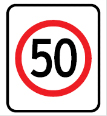 |
Regulatory speed signs It is illegal to drive faster than the posted speed limit. Regulatory speed limit signs have a white background with the speed limit shown inside a red circle. |
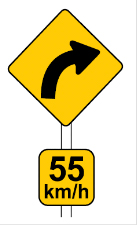 |
Advisory speed signs You should drive at the speed limit on this sign. Advisory speed signs are often placed before curves, bends and crests. |
 |
Local traffic zone sign 40 A local traffic area is an area of local streets that have a speed limit of 40km/h. The lower speed limit provides greater safety for all road users and lower noise levels for people living in the area. Look out for bicycle riders, pedestrians and children. |
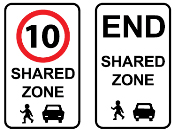 |
Shared zone sign 10 A shared traffic zone is usually a street where pedestrians, bicycle riders and other vehicles can share the road safely. These zones often have a speed limit of 10km/h. Be sure to keep to the speed limit for the safety of all road users. |
 |
Road work sign 40 Where a road work speed limit sign is displayed, the speed limit is enforceable and must be obeyed. |
  |
School zone signs You must drive at 40km/hr in a school zone during school days and the times noted on the sign. You can drive at up to 60km/h once you have left the school zone. |
School road safety resources
It is important that teachers and other educators teach children about road safety to keep them safe on all Northern Territory (NT) roads.
Teachers can also book a road safety lesson or bike education course for students.
Road safety resources for teachers
The Safer Roads teacher resources provide teachers with teaching and learning strategies so they can integrate a road safety program in their classroom.
These resources are evidence-based and provide an outcome focused on the curriculum to the NT Curriculum Framework and National Curriculum.
Early childhood teacher resource for students in transition to year 3
Background information PDF (262.8 KB)
Road Safety Education PDF (210.9 KB)
Focus area 1 - Passenger safety PDF (1.8 MB)
Focus area 2 - Pedestrian safety PDF (1.9 MB)
Focus area 3 - Playing safely PDF (756.3 KB)
Focus area 4 - Sensing traffic PDF (1.4 MB)
Teaching and learning strategies PDF (431.4 KB)
Primary years teacher resource for students in year 3 to 6
Background information PDF (246.7 KB)
Focus area 1 - Passenger safety PDF (725.2 KB)
Focus area 2 - Pedestrian safety PDF (921.4 KB)
Focus area 3 - Safety on wheels PDF (449.8 KB)
Focus area 4 - Road rules and signs PDF (630.3 KB)
Teaching and learning strategies PDF (1.0 MB)
Middle years teacher resource for students in year 7 to 12
Background information PDF (689.9 KB)
Focus area 1 - Drug use issues PDF (1.3 MB)
Focus area 2 - Predicting and responding to drug use risks and consequences PDF (1.1 MB)
Focus area 3 - Road user issues PDF (1.9 MB)
Focus area 4 - Road user risk and harm reduction strategies PDF (817.0 KB)
Road safety activity sheets for children
You can teach students about road safety and pedestrian rules using the below home activity sheets.
Passenger safety
Safety door sticker PDF (64.8 KB)
I am a safe passenger PDF (59.7 KB)
Safer passengers PDF (43.3 KB)
Using public transport PDF (41.5 KB)
Pedestrian safety
Safer places to cross PDF (40.2 KB)
Take a walk together PDF (56.7 KB)
Getting in and out PDF (61.4 KB)
Staying safer in carparks PDF (55.1 KB)
Crossing the road PDF (55.7 KB)
To and from the bus PDF (44.9 KB)
Walking talking day PDF (42.8 KB)
Safer ways to get to and from schools PDF (42.8 KB)
Bike and off-road safety
Helmet safety check PDF (47.3 KB)
Choosing and fitting helmets PDF (52.9 KB)
Off-road injuries PDF (44.4 KB)
Sensing traffic
Bright clothes day PDF (55.0 KB)
Other resources
Seatbelts
An approved seatbelt or child restraint is the easiest way to stay safe in a vehicle.
Research shows that wearing a seatbelt doubles your chances of surviving a serious crash.
You and your passengers must wear a seatbelt or sit in a child restraint that has been appropriately fitted and fastened.
Passengers must not ride in the back of utes or vans unless an approved seatbelt is available.
If drivers don't follow these rules, you could face seatbelt offences and penalties. Passengers over the age of 16 could also be fined.
Pregnancy and seatbelts
If you're pregnant, you still must wear a seatbelt in a vehicle at all times.
You must place the:
- lower part of the seatbelt over your upper thighs, across your hips and below your baby.
- upper part of the seatbelt over your shoulder, between your breasts and above your baby.
Seatbelt buckle cover
A buckle cover is an accessory that goes over the top of a seatbelt buckle.
It stops a passenger from releasing their seatbelt while travelling.
Medical practitioners and health professionals, such as occupational therapists, prescribe them for children or adults with a disability or medical condition.
Seatbelt buckle covers can cause conflict with vehicle standards for seatbelts that requires 'easy release' of the seatbelt by the user.
Exemption
On 16 March 2022, an exemption was issued to allow seatbelt buckle covers to be used in certain cases.
The conditions of the exemption are:
- the seatbelt must be fitted with a prescribed device
- an 'advice to parents' form or medical certificate is in the vehicle
- instructions for the prescribed device is in the vehicle
- the passenger, to whom an 'advice to parents' form or medical certificate has been issued, is using the seatbelt with the prescribed device.
The exemption doesn't apply to a prescribed device fitted to a child restraint's seatbelt buckle.
How to apply for exemption
If you're a parent or carer wanting to use a seatbelt buckle cover, you must talk to a medical practitioner or health professional.
They will assess the needs of the child or adult, and where a seatbelt buckle cover is prescribed, they can issue a:
- signed and completed 'advice to parent' form for children under 16 or
- medical certificate for an adult passenger.
To find out more about the exemption, read the information sheet.
Exemption to use a seatbelt buckle cover information sheet PDF (577.7 KB)
Exemption to use a seatbelt buckle cover information sheet DOCX (55.1 KB)
If you get a form or certificate
If you're approved to use a seatbelt buckle cover, you must keep the below in the vehicle at all times:
- form or medical certificate
- instructions on how to use the buckle cover.
The driver must also present a copy of the form or certificate if requested by a police officer.
Safe and accessible transport for children
For resources and support on transport safety for children with a disability or medical condition, go to the Mobility and Accessibility for Children in Australia website.
Speed limits
A vehicle's speed can affect the risk of a crash and the severity of injuries.
The faster you drive, the longer it takes your vehicle to stop.
Speed limit signs tell you the maximum speed you're allowed to drive in good conditions.
If you drive over the speed limit, you:
- dramatically increase the risk of being involved in a crash
- could face traffic offences and penalties.
To avoid offences or penalties and reduce your risk of crashing, you must:
- obey the road rules
- follow the speed restrictions for your licence, permit and area or drive at a speed to suit:
- traffic conditions
- type and conditions of the road
- weather conditions
- capabilities of your vehicle
- your own driving ability
- follow the default speed limits - where there is no posted speed limit sign
- allow enough time to travel to your destination so you don't need to speed.
Speed restrictions for your licence
For your driver licence type or permit, there are certain speed limits you must follow.
Learner licence holders
Learner licence holders are restricted to a maximum speed of 80km/h - unless accompanied by a licensed driving instructor.
Provisional licence holders
Provisional licence holders are restricted to a maximum speed of 100km/h.
Heavy vehicle licence holders
Drivers of heavy vehicles must not exceed a maximum speed of 100km/h.
Heavy vehicles include:
- buses of more than five tonnes gross vehicle mass (GVM)
- other heavy vehicles of more than 12 tonnes GVM.
Vehicles under permit conditions
Vehicles travelling under permit conditions may also have a maximum speed imposed.
Read more about driver licence classes and conditions.
Default speed limits
In and outside built-up areas, there are different default speed limits you must follow.
A built-up area is an area where there:
- are buildings, not over 100 metres apart, next to the road
- are street lighting at intervals under 100 metres for a distance of at least 500 metres, or for the whole road if the road is shorter than 500 metres.
Speed limits in built-up areas
In built-up areas, a default speed limit of 60km/h applies - unless the town has gazetted a lower default speed limit.
Many towns and communities across the NT have chosen to have a default speed limit of 50km/h or less.
Where a default speed limit applies to a built-up area, a speed limit sign is placed on each road approaching that locality.
Speed limits outside built-up areas
Outside built-up areas, the default speed limit is 110km/h - unless a speed limit sign states otherwise.
Other speed limits apply in some areas.
For example, some sections of the following highways has a maximum speed of 130km/h as indicated:
- Barkly Highway
- Stuart Highway
- Victoria Highway
- Arnhem Highway.
Speed limits near schools and road works
Around schools and road works, there are certain speed limits you must follow.
School speed limit
You must drive at 40km/h or less in a school zone.
This speed limit only applies on school days and during the times shown on the sign.
Road work speed limit
At work zones, temporary road work signs are used to warn drivers and riders to:
- slow down
- look out for any hazards.
You must:
- be prepared to stop
- obey any signal from a traffic controller and give way to any worker
- follow the speed limit signs.
Contact
If you have any questions, email road.safety@nt.gov.au.
You can also refer to the Road Users' Handbook.
Tyre load and speed rating
This page explains the load limit and speed rating for your vehicle's tyres.
The tyre load and speed rating are shown on the tyre sidewall as pictured below.

Tyre load index
| Load index | Load in kilograms per tyre | Load index | Load in kilograms per tyre |
|---|---|---|---|
| 62 | 265 | 63 | 272 |
| 64 | 280 | 65 | 290 |
| 66 | 300 | 67 | 307 |
| 68 | 315 | 69 | 325 |
| 70 | 335 | 71 | 345 |
| 72 | 355 | 73 | 365 |
| 74 | 375 | 75 | 387 |
| 76 | 400 | 77 | 412 |
| 78 | 425 | 79 | 437 |
| 80 | 450 | 81 | 462 |
| 82 | 475 | 83 | 487 |
| 84 | 500 | 85 | 515 |
| 86 | 530 | 87 | 545 |
| 88 | 560 | 89 | 580 |
| 90 | 600 | 91 | 615 |
| 92 | 630 | 93 | 650 |
| 94 | 670 | 95 | 690 |
| 96 | 710 | 97 | 730 |
| 98 | 750 | 99 | 775 |
| 100 | 800 | 101 | 825 |
| 102 | 850 | 103 | 875 |
| 104 | 900 | 105 | 925 |
| 106 | 950 | 107 | 975 |
| 108 | 1,000 | 109 | 1,030 |
| 110 | 1,060 | 111 | 1,090 |
| 112 | 1,120 | 113 | 1,150 |
| 114 | 1,180 | 115 | 1,215 |
| 116 | 1,250 | 117 | 1,285 |
| 118 | 1,320 | 119 | 1,360 |
| 120 | 1,400 | 121 | 1,450 |
| 122 | 1,500 | 123 | 1,550 |
| 124 | 1,600 | 125 | 1,650 |
| 126 | 1,700 |
Tyre speed rating
| Speed symbol | Speed in kilometres per hour (km/h) |
|---|---|
| J | 100 |
| K | 110 |
| L | 120 |
| M | 130 |
| N | 140 |
| P | 150 |
| Q | 160 |
| R | 170 |
| S | 180 |
| T | 190 |
| H | 210 |
| V | 240 |
| W | 270 |
| Y | 300 |
| VR | 210 |
| ZR | 240 |
About inspections
Inspectors must check the speed and load rating of all tyres on the vehicle when doing a roadworthy check.
Tyre ratings must meet the standards of the vehicle maker.
Vehicles with special tyres and wheels different to what was first provided by the vehicle manufacturer must have been approved by the technical advisory committee (TAC) and have a TAC certificate.
Vehicle safety
Safer cars mean less crashes and, in the event of a crash, less risk of death or serious injury.
Star rating
The Australasian New Car Assessment Program (ANCAP) tests new vehicles and rates their safety from one to five stars indicating the level of safety a vehicle provides for occupants and pedestrians in the event of a crash.
Check the ANCAP star rating of a vehicle before you buy.
Roadworthiness
Driving a vehicle that is roadworthy is crucial to your safety and that of other road users.
Roadworthy vehicles must comply with standard vehicle requirements including wheels and tyres, steering, brakes, seatbelts, lamps and reflectors, exhaust and emission controls, windscreens and wipers and vehicle body and chassis.
In the Northern Territory, roadworthy inspections are required for new cars after five years, 10 years and then annually. Check if your car needs a roadworthy inspection.
Takata airbag - safety recall
The Australian Government announced a compulsory recall for all vehicles with defective Takata airbags in 2018.
Find out if your vehicle is part of this recall and if registration sanctions apply.
Buying a used vehicle
Before you buy a used vehicle from a private seller, be aware that it can come with some risk.
Find out what you should do when buying a used vehicle.
Changes to light trailer importing and manufacturing laws
From 1 July 2023, new laws will come into effect around importing and manufacturing light trailers.
If you manufacture or import low aggregate trailer mass (ATM) trailers, you will need approval from the Australian Government to bring them in or provide them to the Australian market.
Light trailers have an ATM of 4.5 tonnes or less.
Transitional arrangements are in place until 30 June 2023. Read more on the Department of Infrastructure, Transport, Regional Development and Communications website.
What the changes mean
Once the laws change, you will no longer:
- self certify that your trailer meets vehicle standards
- need trailer compliance plates on your trailer - vehicle plate requirements will apply.
All trailers will need to have trailer compliance information listed on the Register of Approved Vehicles (RAV) online database.
Approvals
Two types of approval will be available:
- vehicle type approval
- concessional RAV entry approval.
The approval you need depends on how many trailers you plan to manufacture or bring into Australia.
Read below to find out which approval you need.
Provide more than 4 trailers in 12 months
If you provide more than 4 low ATM trailers to the Australian market in a 12-month period, you must apply for a vehicle type approval.
A vehicle type covers a make of trailer and a trailer category.
Provide 4 or fewer trailers in 12 months
If you provide 4 or fewer low ATM trailers to the Australian market in a 12-month period, you must apply for a concessional approval.
The Northern Territory will no longer issue a vehicle identification number (VIN) for a trailer that falls under this category.
The Australian Government will issue you a VIN as part of the approval process.
For a printable version of the changes, get the fact sheet PDF (574.4 KB).
How to apply
To apply for approval or for more information, go to the Department of Infrastructure, Transport, Regional Development and Communications website.
Contact
To find out more, email RVSAimplementation@infrastructure.gov.au or call 1800 815 272.
If you're overseas, call +61 2 6274 7444.

